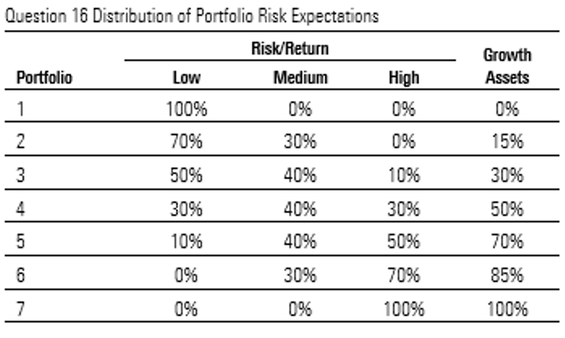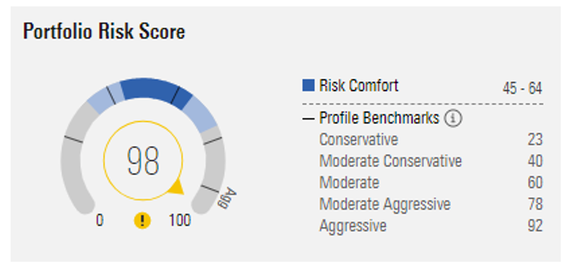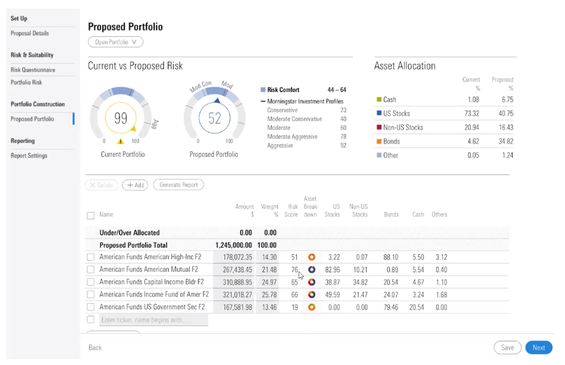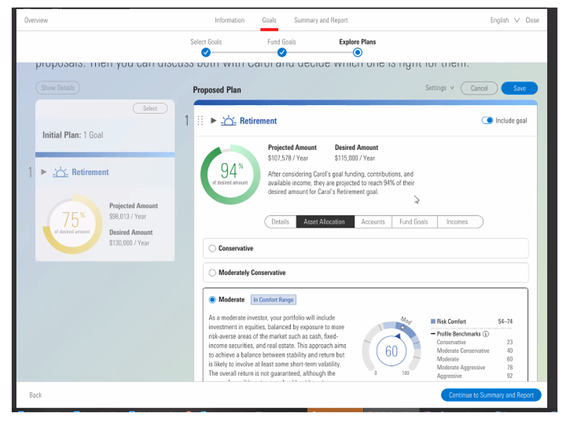Financial professionals have plenty of challenges nowadays, with the rise of robo-advisors, greater scrutiny by regulators, and legions of people taking a do-it-yourself approach to investing. While there’s still a tremendous need for good financial planning, financial professionals must do more to set their services apart, and we think having deeper conversations with clients about risk will play an even bigger role going forward.
More specifically, how much risk is a client truly comfortable taking on? Financial professionals can differentiate themselves by presenting clients with a transparent, proven, and reliable way to gauge risk comfort.
Historically speaking, most risk-profiling products have failed to meet the true needs of investors or, by extension, the financial professionals who serve them. The approaches have focused too much on measuring the risk of investments within a portfolio, without any sound methodology to gauge a client’s willingness and ability to take on risk and how to map it to investment plans. It has been a big missing piece of the financial-planning puzzle.
All too often, clients are pigeonholed into one of five risk bands, ranging from “One” for conservative or low risk to “Five” for aggressive or high risk, using simplistic, unproven questionnaires that don’t reflect the client’s risk comfort or expectations. This system often has had negative consequences, with investors besieging financial professionals during market downturns, wanting out of their investments, demanding that holdings be sold at the worst possible time. On the flip side, clients who had a higher comfort for risk missed out on potential market growth.
Accurately gauging risk comfort is good for business, and financial professionals should approach it from a regulatory perspective, too. Increasingly, regulators are demanding more documentation to show that financial professionals have acted in the best interests of their clients, and advisors need something transparent, defensible, and easy to understand, with a sound, empirically based methodology to back it up.
But how do you bridge that gap between risk comfort—something that's personal and psychological—and portfolio risk—which is based on hard financial and portfolio-construction metrics?
As part of Morningstar’s Risk Ecosystem, which we have been rolling out to financial professionals this year, we recently debuted the “Risk Comfort Range,” a methodology used to map client expectations of portfolio risk exposure with their investor profile. When risk expectations are aligned, financial professionals can help bring calm and peace of mind even when markets are volatile.
Breaking Down Risk Tolerance and Risk Comfort
We start with risk tolerance, a psychological trait of an individual's willingness to take risk to achieve better financial returns. Risk tolerance is fairly stable over time.
Few options have existed on the market that accurately assess risk tolerance, in part because of inadequate questionnaires, which have little academic research or empirical evidence to support the validity of the methodology. By contrast, Morningstar uses a psychometric risk tolerance questionnaire, or RTQ, that has been rigorously tested by academics and has stood the test of time, with 2 million responses over 20 years.
Although the tolerance score forms the foundation of the risk profile, it is insufficient on its own to be the basis of advice and should be adjusted based on a variety of other factors, such as prior investing experience, investment knowledge, the time horizon of the investment plan, the return required by a client to achieve goals, and the ability of the client to manage in the event that markets provide poor outcomes (capacity for loss)—considerations that our system aggregates into a Suitability Score.
Determining a Risk Comfort Range
Our Risk Comfort Range is built on data from the questionnaire itself. One of the questions asks respondents to select a preferred portfolio from a set of seven (see Exhibit 1). Each portfolio is expressed as a mix of investments categorized as low risk/return, medium risk/return, and high risk/return and reflects a level of growth or risky assets. Cash and fixed/bank deposits are given as examples of low-risk/return investments, and stocks/shares/equities and property/real estate are given as examples of high-risk/return investments. This makes it easy for respondents to give answers because the categories are in plain language.
Exhibit 1 
Using our historical database of completed risk tolerance tests, the average percentage of growth assets was calculated for each specific risk tolerance score (the dotted gray line in Exhibit 2). These averages are consistent with answers to other investment-related questions.
On the other side of the equation, our recently launched Morningstar Portfolio Risk Score, a measure of portfolio risk and diversification based on the Morningstar Target Allocation Indexes, provides a robust measure of growth assets as it is highly correlated to the level of growth/equity exposure for a well-diversified portfolio. An MPRS of 60 equates to a well-diversified portfolio that is 60% growth/equity assets.
Bringing the two together, a risk tolerance or Suitability Score of 50 maps to an average of 45% growth assets or MPRS of 45. We have set the Risk Comfort Range at 36 to 55 (the dark blue area) at positive 10% to negative 10% (reflecting the standard deviation of responses for the question about clients’ risk and return expectations) and the marginal comfort range (light blue), or what we call “near comfort,” at positive 20% to negative 20%, beyond which is too much or too little risk. Clients are most comfortable within the Risk Comfort Range and have increasing discomfort from either too much or too little risk as they move further away from this range.
Exhibit 2 
How Risk Comfort Range Can Help Generate Meaningful Conversations
We can link the Risk Comfort Range to the risk of any portfolio using the MPRS. So for each scenario, financial professionals can model out what the long-term expectation is based on capital market assumptions.
Say a financial professional meets with a new client, enters in the person’s holdings, and the MPRS is a 98 (see Exhibit 3). Yet from the Morningstar Risk Profile, the client’s Risk Comfort Range is 45 to 64. In this case, the portfolio score is well outside the client’s Risk Comfort Range. Then the financial professional can have a conversation with the client to adjust the portfolio to better align with the Risk Comfort Range.
Exhibit 3 
Exhibit 4 
As a financial professional, you can give clients a baseline range of risk that they would be comfortable with. If they choose to take on more risk, they are doing it knowingly, and the decision is properly documented. The clients’ expectation is that they are exposing themselves to high volatility while positioning for a potentially higher reward.
Using Risk Comfort Range in Goal Setting
When financial professionals set dollar-amount goals for portfolios, risk comfort can be used to make sure they’re not stepping outside of the range as they seek to fund their objectives. For example, risk comfort will be integrated into Morningstar’s Goal Bridge, which helps financial professionals connect goal setting and investment plans. The financial professional can model scenarios of goal funding with different assumptions about savings, time horizon, and risk level. In the example below, the financial professional adjusts a retirement goal to move a projection to 94% of a desired amount, up from 75%. Along the way, the software shows whether the client can meet the funding needs while still remaining in the Risk Comfort Range (see Exhibit 5).
Exhibit 5 
Why Risk Comfort Matters
Our approach to determining risk tolerance has stood the test of time, with rigorous, empirically based methodology, every step of the way. Pairing that with the rigor of Morningstar’s new Portfolio Risk Score can help financial professionals have more-meaningful conversations with their clients about risk/reward trade-offs and demonstrate for compliance purposes that they’re acting in the best interests of clients.
Yet more than anything, talking about Risk Comfort Range, and linking it back to portfolio risk, will deepen the conversation with your clients and build trust. It’s a holistic approach, and your clients will be better informed. At a time when several aspects of financial advisement have become commoditized, financial professionals can now access these powerful tools to help them better differentiate themselves in a highly competitive market.

